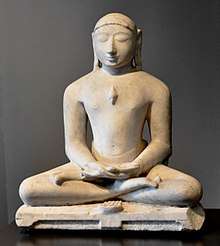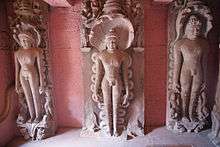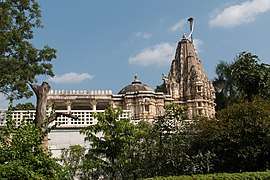Suparshvanatha
| Suparshvanatha | |
|---|---|
| 7th Jain Tirthankara | |
 Idol of Suparśvanātha | |
| Venerated in | Jainism |
| Predecessor | Padmaprabha |
| Successor | Chandraprabha |
| Symbol | Swastika |
| Height | 200 bows (600 meters) |
| Age | 2,000,000 purva (141.12 Quintillion years) |
| Color | Golden |
| Personal information | |
| Born | Varanasi |
| Died | Shikharji |
| Parents |
|
| Part of a series on |
| Jainism |
|---|
 |
|
Jain prayers |
|
Ethics |
|
Major sects |
|
Festivals |
|
|
Suparśvanātha (Sanskrit: सुपर्श्वनाथ Suparśvanātha) was the seventh Jain Tīrthankara of the present age (avasarpini). He was born to King Pratistha and Queen Prithvi at Varanasi on 12 Jestha Shukla in the Ikshvaku clan. He is said to have attained moksha at Śikharji on the sixth day of the dark half of the month of Phālguna'.
Life story
Suparśvanātha was the seventh Jain Tīrthankara of the present age (avasarpini).[1] He was born to King Pratistha and Queen Prithvi at Varanasi on 12 Jestha Shukla in the Ikshvaku clan.[1] He is said to have attained moksha at Śikharji on the sixth day of the dark half of the month of Phālguna.[2]
Nine months before the birth of Suparśvanātha, Queen Prithivī dreamt the sixteen most auspicious dreams.[3] Suparśvanātha spent 5 lakh pūrva as youth (kumāra kāla) and ruled His kingdom for 14 lakh pūrva and 20 pūrvāṇga (rājya kāla).[2]
As a historical figure
The Yajurveda is also said to have mentioned the name of Suparśvanātha but the meaning is different. It is an epithet of God which means "All-Pure Lord".
The Mahavagga book of the Khandhaka (1. 22. 13), a Buddhist text, mentions a temple of Suparśvanātha situated at Rajgir in the time of Gautama Buddha.[4]
At Mathura, there is an old stupa with the inscription of 157 CE. This inscription records that an image of the tīrthankara Aranatha was set up at the stupa built by the gods.[4]
Adoration
Svayambhūstotra by Acharya Samantabhadra is the adoration of twenty-four Tīrthankaras. Its five slokas (aphorisms) are dedicated to Tīrthankara Suparśvanātha.[5]
As an inanimate equipment (a vehicle, for example) requires an animate being (a man) for its operation, so does the body, that the soul adopts as its encasement, require the soul for its functioning. The body is repugnant, foul-smelling, perishable, and a source of anxiety and, therefore, it is futile to have attachment towards it. O Lord Suparśvanātha, this is your benign precept.
— Svayambhūstotra (7-2-32)[6]
Suparshvanatha is associated with Nandyavartha (Dig.) & Svastika (Svet.) emblem, Sirisa tree, Varanandin (Dig.) & Matanga (Svet.) Yaksha and Kali (Dig.) & Santa (Svet.) Yakshi.[7]
Gallery
- Jina Suparsvanatha from Karnataka, India, c. 900 CE, schist, Norton Simon Museum
- 16th century bronze idol of Suparsvanatha, Honolulu Museum of Art
- Jain chaumukha sculpture with Suparshvanath and Three Other Tirthankaras, 1st century
 Supārśva in middle with Pārśva on both side, Jain temple, Deogarh
Supārśva in middle with Pārśva on both side, Jain temple, Deogarh Suparshavanath Temple at Ranakpur
Suparshavanath Temple at Ranakpur
See also
| Wikimedia Commons has media related to Suparshvanatha. |
Notes
- 1 2 Tukol 1980, p. 31.
- 1 2 Vijay K. Jain 2015, p. 189.
- ↑ Vijay K. Jain 2015, p. 188.
- 1 2 Jain 2009, p. 77.
- ↑ Vijay K. Jain 2015, p. 44-50.
- ↑ Vijay K. Jain 2015, p. 45.
- ↑ Tandon 2002, p. 44.
References
- Johnson, Helen M. (1931), Suparshvanathacaritra (Book 3.5 of the Trishashti Shalaka Purusha Caritra), Baroda Oriental Institute
- Jain, Vijay K. (2015), Acarya Samantabhadra’s Svayambhustotra: Adoration of The Twenty-four Tirthankara, Vikalp Printers, ISBN 9788190363976, archived from the original on 16 September 2015,
Non-Copyright
- Tandon, Om Prakash (2002) [1968], Jaina Shrines in India (1 ed.), New Delhi: Publications Division, Ministry of Information and Broadcasting, Government of India, ISBN 81-230-1013-3
- Tukol, T. K. (1980), Compendium of Jainism, Dharwad: University of Karnataka
- Jain, Arun Kumar (2009), Faith & Philosophy of Jainism, Gyan Publishing House, ISBN 9788178357232, retrieved 2017-09-23